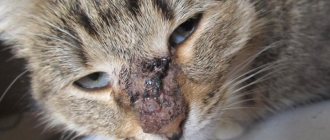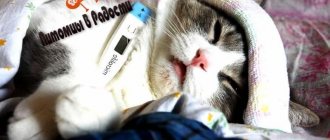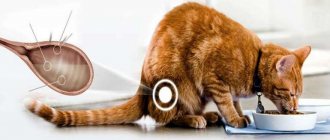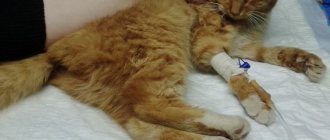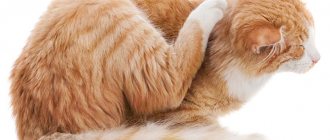Leptospirosis in cats. Myth or reality?
Despite the presence of antibodies to Leptospira in the cat population, reports of a full-blown clinical picture of leptospirosis in cats are rare.
. Although cats change serological status after exposure to Leptospira, they are less susceptible to both spontaneous and experimental infection. Serologic studies of stray and shelter cats in the Midwestern States have shown very low incidence (less than 3%) with positive results for antibodies to serogroups Autumnalis, Bratislava, and others.
Leptospirosis is a bacterial infection caused by spirochetes. Leptospirosis occurs in cats when Leptospira penetrates the skin and spreads through the body through the bloodstream. The two most commonly found members of this subspecies of bacteria in cats are Leptospira grippotyphosa and Leptospira pomona. Spirochetes are spiral or corkscrew-shaped bacteria that penetrate body systems through the skin and mucous membranes.
Leptospira spreads throughout the cat's body
, multiplying in cells of the liver, kidneys, central nervous system, eyes and reproductive system. Shortly after the initial infection, cats develop fever and a bacterial blood infection, but these symptoms soon resolve with a reactive increase in antibodies that clear Leptospira from most organ systems. The extent to which organs are affected by these bacteria will depend on the cat's immune system and its ability to completely clear the infection. Even then, Leptospira spirochetes can remain in the kidneys and continue to multiply there. Infection of the liver or kidneys in cats can be fatal, especially when the infection progresses, causing severe damage to internal organs. Young cats with less developed immune systems are at increased risk of severe complications, as are cats with already weakened immune systems.
Leptospira bacteria are zoonotic, meaning that they can be transmitted from an infected animal to humans and other animals. Children are at greatest risk of contracting this bacterium. There is an extremely low risk of infection from cats.
Symptoms and signs of leptospirosis in cats
- Sudden fever and illness
- Muscle pain, reluctance to move
- Stiffness in muscles, legs, stiff gait
- Shiver
- Weakness
- Depression
- Lack of appetite
- Increased thirst and urination leading to an inability to urinate may indicate chronic kidney failure
- Rapid dehydration
- Vomiting, possibly blood
- Diarrhea—with or without blood in the stool
- Bloody vaginal discharge
- Dark red speckled hemorrhages on the gums (petechiae)
- Yellow skin and/or pale whites of the eyes are symptoms of hemolytic anemia
- Spontaneous cough
- Difficulty breathing, rapid breathing, irregular pulse
- Runny nose
- Swelling of the mucous membrane
- Mild swelling of the lymph nodes
- Etiology (causes) of leptospirosis in cats
Infection caused by bacteria of the genus Leptospira
, found mainly in subtropical, tropical and humid environments. Leptospira spirochetes are most common in swampy/muddy areas with stagnant surface water. Heavily irrigated pastures are also common sources of infection. The incidence of diseases in pets is increasing worldwide, with infections most often occurring in the autumn season. Cats usually come into contact with Leptospira bacteria in contaminated soil or dirt, from drinking or being in contaminated water, or from contact with the urine of an infected animal. This latter method of contact may occur in the wild. Cats that live near forested areas or cats that live on or near farms are at higher risk of contracting the bacteria. Cats that are kept with other animals, such as in kennels, are also at increased risk of contracting leptospirosis. Otherwise, since most cat breeds do not spend much time near water, leptospirosis infection is rare in cats.
Pancreatic diseases
Consider a disease such as pancreatitis in cats, the symptoms of which you need to know and cannot be delayed.
Comprehensive treatment is carried out. Pain and vomiting are relieved using medication. Next, bacterial complications are treated and insulin therapy is administered for diabetes caused by this disease. The animal is monitored until it recovers completely.
Diagnosis of leptospirosis in cats
Because leptospirosis is a zoonotic disease, veterinarians will take extra care when handling your cat and strongly encourage you to do the same. Protective latex gloves must be worn at all times and all body fluids will be treated as biohazardous materials. Urine, semen, post-abortion or labor discharges, vomit, and any fluid that leaves the body must be handled with extreme care.
You will need to describe your cat's medical condition in detail, including history of symptoms, recent activities, and possible incidents that may have caused the condition. The medical history you provide can give your veterinarian information about what stage of leptospirosis infection your cat is in and which organs are most affected.
Your veterinarian will then perform a blood chemistry profile, complete blood count, urinalysis, electrolyte test, and urine fluorescent antibody test. Urine and blood cultures will also be ordered to study the prevalence of leptospirosis. A microscopic agglutination test or anti-leptospirosis antibody titer test will be performed to measure your cat's immune response to the infection by measuring the presence of antibodies in the blood. This will help accurately identify Leptospira and the level of systemic infection that is occurring in cats.
Clinical symptoms of leptospirosis in cats are usually mild or inconspicuous despite leptospiraemia and leptospiruria. Histologically proven inflammation of the kidneys and liver. Increased testing of cats with acute hepatitis and renal disease may lead to an increase in the number of identified cases of leptospirosis in this species.
Lambiasis
With this disease, the small intestine is damaged by protozoan parasites. Infection occurs through consumption of water and food contaminated with Giardia protozoa. A person can also become infected from a cat, so you need to be extremely careful when cleaning the cat's litter box. Symptoms include changes in stool, diarrhea or diarrhea, and sometimes worms are visible in the stool. As we see, protozoan parasites and pathologies in cats are mutually related. And in order to begin proper treatment, you need to conduct an accurate diagnosis of which protozoan caused a specific disease.
Treatment
Your cat should be hospitalized if she becomes seriously ill with this infection. Fluid therapy will be the primary therapy to reverse any effects of dehydration. If your cat has been vomiting, an antiemetic medication may be prescribed and a gastric tube may be placed. which can be used for feeding if a medical condition is preventing your cat from eating. A blood transfusion may also be needed if your cat has had severe bleeding, hemolysis, or anemia.
Antibiotics will be prescribed by your veterinarian for at least four weeks, with the type of antibiotic depending on the stage of the infection. Penicillins can be used for initial infections, but they are not effective at killing bacteria once they have reached the host stage. Tetracyclines, fluoroquinolones or similar antibiotics will be prescribed for the vector stage as they distribute better into bone tissue. Some antibiotics can have serious side effects, especially those drugs that go deeper into the system to clear up the infection. Be sure to read any warnings that come with your prescription and talk to your veterinarian about any adverse indications you will need to monitor for. The prognosis for recovery is usually positive, with the exception of serious cases of organ damage.
general characteristics
Under a microscope, Leptospires appear as slender parasites with a corkscrew shape. Science knows that there are a huge number of types and serological groups of such a parasite in nature. Fortunately, they are not resistant to disinfectants, do not tolerate sudden changes in temperature and practically do not survive in the external environment.
It is important to understand that the bacterium is transmitted not only from sick cats, but also from animals that have already recovered from the disease. Your furry friend can become infected through the urine, feces or milk of Leptospira carriers. Even after full therapy, the cat remains a carrier of the microorganism for another 3-4 months.
Veterinarians are convinced that feline leptospirosis is most often spread through food, water and direct contact with an infected animal. Leptospirosis carriage has also been observed in rodents and insects such as ticks and mosquitoes. Bacteria enter the body primarily through the mucous membrane of the digestive tract, respiratory tract and genitourinary system.
Prevention and control measures for leptospirosis in cats
In some areas, vaccination to prevent leptospirosis is available. Your veterinarian can advise you about the availability and usefulness of this vaccine. Be sure to inspect catteries before placing your cat in one—the cattery must be kept clean and rodent-free (look for rodent droppings). Urine from an infected animal should not come into contact with other animals or people. Animals kept in close quarters will come into contact with the urine of other animals even under the best conditions, so cleanliness should be a major factor when choosing a kennel.
The cat's activity should be limited. Arrange for cage housing while your cat recovers from this infection. Leptospirosis is a zoonotic disease transmitted to humans and other animals
through urine, semen and post-abortion discharge. While your pet is undergoing treatment, you will need to keep your pet away from children and other pets, and wear protective latex gloves whenever handling your pet or coming into contact with your pet's urine, feces, or vomit. Areas where your pet has urinated or vomited should be thoroughly cleaned and disinfected with iodine-based products or bleach solutions (chlorine). Gloves should be worn during the cleaning process and disposed of properly afterwards.
Finally, if you have other pets or children at home, they may be infected with Leptospira bacteria and not yet showing symptoms. It may be worth getting them (and yourself) tested for leptospirosis. It is also important to remember that Leptospira may continue to be excreted through the urine for several weeks after treatment and clinical recovery from the infection. Good cat handling practices are the best way to prevent leptospirosis from spreading or becoming reinfected.
^Top
How to treat
Leptospirosis in cats is highly treatable if the animal is brought to the veterinary clinic on time. Self-medication is prohibited! Leptospirosis is dangerous for humans, so you should not conduct any experiments or attempts to cure a cat without the participation of a specialist!
The most important link in therapy is the use of antibiotics!
- Antibiotics of first choice to stop the proliferation of Leptospira in the case of a cat’s severe condition (the first three days) are penicillin and its derivatives: amoxicillin (preferably if administered intravenously) 20 mg/kg twice a day at regular intervals or ampicillin 20 mg/kg every 8 hours
- If an animal is allergic to penicillin antibiotics, it is allowed to use chloramphenicol (20 mg/kg subcutaneously) or streptomycin (20 mg/kg intramuscularly) once a day for 3 days.
- The second stage of antibiotic therapy (destruction of leptospira in the body) is tetracycline antibiotics, in particular doxycycline - 5 mg/kg orally. This stage begins only after the animal begins to eat on its own, vomiting goes away and the absence of liver pathologies is confirmed, because Doxycycline has some hepatotoxicity in cats. It is best used as a hyclate salt rather than a monohydrate (drugs: Ronaxan, Paudox or Doxatib).
- If there was no vomiting or signs of severe intoxication when visiting the veterinary clinic, then therapy can be started immediately with doxycycline. Also, this drug is indicated for cats that are healthy in appearance and that excrete the pathogen in the urine into the external environment, and this has been confirmed in the laboratory.
Symptomatic therapy
Mainly aimed at relieving signs of liver and kidney (especially) failure. Therapeutic regimens are drawn up after a blood test and assessment of the animal’s general condition.
Vitamin preparations and immunomodulators
They are administered at the discretion of the treating veterinarian. Considering the specific course of the disease in cats, leptospirosis is either quickly cured with a satisfactory recovery rate, or progresses rapidly with a fatal outcome. The expediency of use is not always justified.
Good to know
- Trichopolum instructions for veterinary medicine
- Instructions for the use of the antibiotic Baytril in animals
- Instructions for use of metronide
- Instructions for ceftriaxone preparations for animals
- Use of Metrogyl in veterinary medicine
- Instructions for doxycycline in animals
- Metronidazole (Metronidazole) for animals (instructions for use in veterinary medicine, doses, indications and contraindications)
- Atovaquone (ATOVAQUONE)
- Azithromycin, instructions for animal therapy



